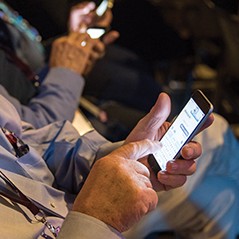
Action-Packed People who lead the call to text on behalf of their organizations are often hesitant at first, according to Phone2Action. However, they ease into the role as they see the map quickly populate with pins.
No matter how rousing it may be, if a call to action takes place during one of many sessions attendees go to during the course of a conference program, they’re likely to forget about following through on it. That is, unless you provide them with immediate steps to take before they even leave the session room.
That is precisely what the American Farm Bureau Federation (AFBF) did at its 98th Annual Convention, which brought approximately 5,000 attendees to Phoenix in January. Advocating on behalf of farmers and ranchers is central to AFBF’s mission, and its annual event, required by the organization’s bylaws, is an important way to help members speak with one voice on issues that directly impact their livelihood. So when AFBF learned about Phone2Action — an advocacy technology company that launched a platform in 2013 enabling users to take action on civic issues right from their cellphones — it decided to partner with the company. As a result, 2017 convention attendees from across the country were given the opportunity to engage with their government representatives during a business session, via a simple text.
THE ADVOCATE
In the first of two general sessions, AFBF President Zippy Duvall made his opening remarks about successes and challenges in the industry before suggesting attendees take action. He asked them to text “AFBF” to a specific phone number. Participants were then immediately sent a link that led them to a pre-written message in support of H.R. 5 — a regulatory reform bill designed to roll back federal overreach and, in the process, preserve farmers’ and ranchers’ land-use and water rights — that would be sent to their congressional representative. All participants needed to do was to fill in their personal details and, if they so desired, alter the pre-written text before pressing the send button.
As participants submitted their messages, an interactive map of the United States — projected onto the main-stage screen — populated based on participants’ home location. By the time Duvall left the stage, more than 1,500 messages had been submitted. For those who did not participate in the event, video displays throughout the course of the meeting provided instructions on how to take action. By the end of the event, 1,895 members had participated in the text campaign, which is still ongoing.
“We had a lot of members who liked the approach,” said Cody Lyon, director of advocacy and political affairs for AFBF. “[They] liked the fact that they had something to do, rather than just listen to a speech.” In fact, the initiative was so well received that several members expressed an interest in running the text campaign during smaller, local meetings.
And while the activity went off without a hitch and seemed effortless, it required some work on the back end.
MAPPING OUT THE MOVEMENT
AFBF followed Phone2Action’s playbook, a guide the company created “to help our partners execute what we call ‘the live call to action,’” said Jeb Ory, co-founder and CEO of Phone2Action. The playbook details a few key components that should be incorporated into any live exercise, and provides pointers to make the appeal engaging. “Our team will coach their executive on how to give the most effective call to action, what to say, how to highlight where people in a certain area are taking action, where others are not,” Ory said. “We work with them to set some goals and benchmarks.”
From there, Phone2Action creates a webpage under the client’s account that displays information about the message that will be sent by participants. When it’s time to begin the activity, the client’s AV team is responsible for displaying both the directions on how to send the text and the interactive map.
“Really then, one of the coolest things about it is it creates a very organic, off-the-cuff activity,” Ory said, “because it’s completely live. Our clients, when they’re up on stage giving that call to action, they actually can look at that map and they can see where support’s coming in from. If they see an area that isn’t as active as they feel like it should be, they’ll say, ‘Hey, come on, Montana. Come on, North Carolina. Where are you?’ That creates a really healthy, competitive vibe between the representatives from different states.”
Lyon found the peer-pressure aspect of the exercise particularly effective.
“You can set a goal of ‘I want to have this number of pins drop before I leave the stage or move to the next thing,’” he said. “There’s a lot of that ‘Let’s reach the goal together’ approach.’”
In addition to peer competition, the mix of visual aids and the speaker’s encouragement contribute to strong participation. But it’s the immediate nature of Phone2Action that is most critical to advocacy efforts.
“The problem — prior to our company — that was most prevalent at a rally or an event or a conference or a lobby day [occurred] when you have a speaker onstage talking about policies,” Ory said. “What do they actually do to mobilize people to take action? They may not do anything. They may say, ‘If you really want to make a difference, go home and call your state senator tomorrow.’ People, when they’re excited about something, they want to do something right then and there.”


